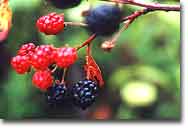
 Blackberries And More Blackberries Blackberries And More Blackberries
Some of you readers may have noticed by now that I can usually find an excuse to get outside and into the “woods” of Southern Indiana. In the spring I hunt for mushrooms and enjoy wildflowers. Summers start off with raspberry season in June, followed by blackberry season in July. And I’ve been promised a lesson in ginseng hunting this fall, so I’ll keep you posted.
Of all my hunter-gatherer forays to date, this year’s blackberry season has been the most fruitful ever. I’m not sure what weather conditions brought on this bumper crop, but so far there are over 20 pounds of fat, juicy blackberries in the freezer, and another 5 pounds in the basket I brought in today. In the past I’ve had to scour the woods, but this year I discovered a clearing that is covered almost entirely with blackberries. I can’t take a step without having to pause to gather the fruit, and with the next step there is another bunch just waiting to be picked or eaten right off the branch. So with a season like this, still going strong as we head into August, I feel compelled to share with you the joys of blackberry picking.
Picking Blackberries
Before going out picking blackberries make sure you’re properly attired. Think “protective wear”. Blackberries grow on thorny bushes, which can latch onto your skin like a cat’s claw. Denim jeans and a long-sleeved tightly-knit shirt are what I always wear. If you will be in heavy bushes you might want to tuck your pants into your socks to keep unwanted poison itch plants or bugs out.
Blackberries can be found near woods or clearings or just about anywhere that birds fly. Take along a basket or something sturdy, since the thorns will rip through grocery bags. Blackberries seem to ripen in clusters, with whole clusters being ready at the same time. Raspberries, which peaked in June, are smaller than blackberries and often only have one ripe berry on the tip of a cluster. Blackberries are ripe when they are plump and very dark purple, almost black. They should come off the stem easily by just rolling them between your thumb and index finger and into the basket. If you have to tug to get them off, they usually aren’t as sweet, so I don’t bother with them. Blackberries range in size from having only a few seeds to being as big as strawberries.
Besides wild, thorny blackberries, there are also thornless cultivars. Some say these aren’t as sweet, but the ones I’ve tasted were sweet, juicy treats with just a slightly different taste. It’s also nice not to be torn up by thorns!
The Harvest
The best way to enjoy blackberries is probably right off the vine. It’s instant reward for your effort, and a nice refreshment on hot days. It’s also nice to have a piece of blackberry cobbler or pie just after they’re picked.
If you have more than you can use at once there are ways to preserve the harvest. The easiest and most versatile option is to freeze them. Another rather simple way to preserve them is to dehydrate them, either in a food dehydrator or a low oven. After they’re dry, store them in an airtight baggy in the cupboard. Dehydrated berries are great in cereal, or can be rehydrated and used like fresh berries. They also take up less space than either frozen or canned berries. If you are so inclined, you can also make jellies, jams, syrups or preserves.
Freezing Blackberries
To freeze blackberries rinse them off in cold water then let them dry off. Lay them out in a single layer on a cookie sheet, then put the cookie sheet and berries in the freezer. After they are frozen solid take a spatula and loosen them from the sheet, then transfer the berries to a freezer bag and return them to the freezer. This method keeps the berries from clumping together when they’re frozen, and when they thaw look almost like the original, fresh berries. There’s nothing quite like eating freshly-picked berries in the summer. But if you put a few back now, you can also enjoy a warm blackberry cobbler this winter!
<back to top>

|